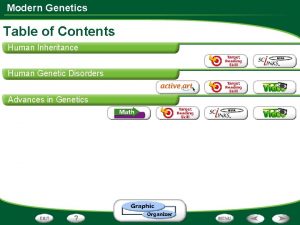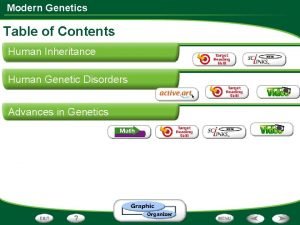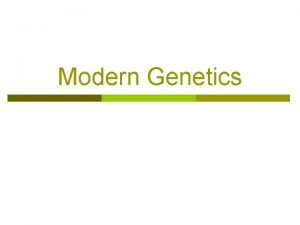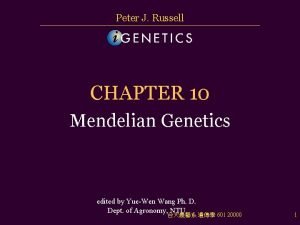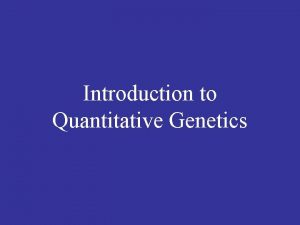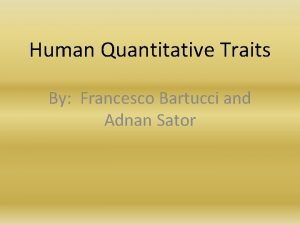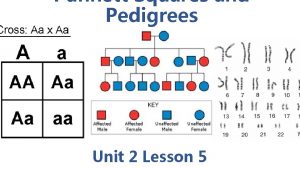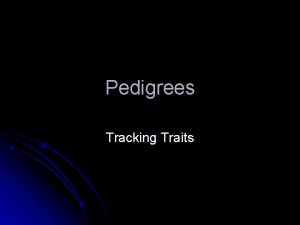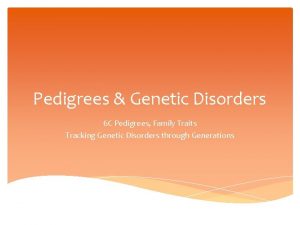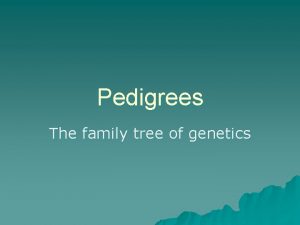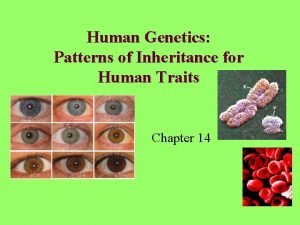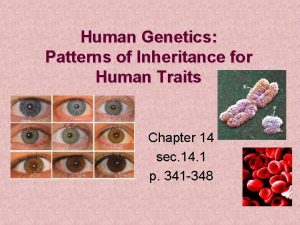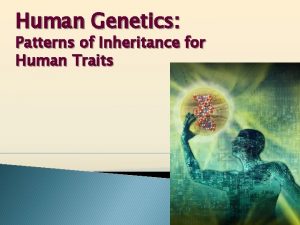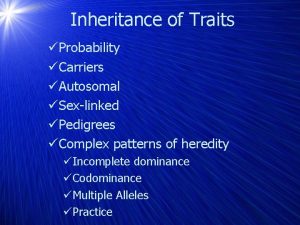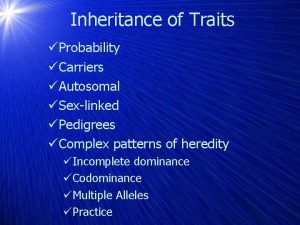Human Genetics Inheritance of Traits Pedigrees Diagrams that













- Slides: 13

Human Genetics

Inheritance of Traits Pedigrees Diagrams that reveal inheritance patterns of genes Geneticists use to trace diseases/traits through families

Genetic Traits/Disorders Polygenic Inheritance Polygenic characters controlled by two or more genes Ex) skin color Complex Characters Trait influenced by both genes and the environment— Human Height Multiple Alleles Controlled by three or more alleles of a gene Ex) ABO blood type

Human Blood Human blood is controlled by a gene with multiple alleles 4 main blood types: A, B, AB, and O The allele for blood types A and B are codominant The allele for blood type O is recessive


Genetic Traits/Disorders X-Linked Traits An X-Linked recessive gene is found on the X Chromosome EX) Colorblindness Sex Influenced Trait or Sex-Linked Trait on the X or Y chromosome Expressed differently in men than in women even if it is on an autosome and both sexes have the same genotype Ex) Male Pattern Baldness

Inheritance of Colorblindness=sex-linked trait controlled by recessive allele on the X chromosome Carrier: person who has one recessive allele for a trait and one dominant allele Carrier does not have the trait Carrier can pass the recessive allele Only females can be carriers Females are rarely colorblind…. WHY? ?


Genetic Disorders: an abnormal condition that a person inherits through genes or chromosomes Causes of Genetic Disorders: Mutations in the DNA of Genes Changes in the overall structure or number of chromosomes Many of the athletes that compete in the Special Olympics have disabilities that result from genetic disorders

Common Genetic Disorders 1) Cystic Fibrosis Genetic Disorder in which the body produces abnormally thick mucus in the lungs and intestines Thick mucus fills the lungs, making it hard to breathe Caused by a recessive allele on chromosome number 7 Results from a mutation of DNA

Common Genetic Disorders 2) Sickle-Cell Disease affects hemoglobin, a protein in red blood cells that carries oxygen Lacking oxygen in the red blood cells give them their sickle shape Sickle shaped red blood cells clog blood vessels and cannot carry as much oxygen Sickle-cell trait is codominant with the normal allele Just one DNA base is changed on 11 th Chromosome

Common Genetic Disorders 3) Hemophilia Genetic Disorder in which a person’s blood clots very slowly or not at all Do not produce one of the proteins needed for normal blood clotting Small bumps and bruises extremely dangerous Caused by a recessive allele on the X chromosome Sex-linked-----occurs more frequently in males

Common Genetic Disorders 4) Down Syndrome A person’s cells have an extra copy of chromosome 21 Instead of having a pair of chromosome 21, they have three of that chromosome Most often occurs when chromosomes fail to separate properly during meiosis People with down syndrome have some degree of mental retardation and some heart defects
 Human inheritance modern genetics answer key
Human inheritance modern genetics answer key Human clone
Human clone Modern genetics human inheritance answer key
Modern genetics human inheritance answer key Dihybrid cross branch diagram
Dihybrid cross branch diagram Use case model
Use case model Activity diagrams are static diagrams
Activity diagrams are static diagrams Quantitative and qualitative traits
Quantitative and qualitative traits Dominant genetic variance
Dominant genetic variance Inheritance of quantitative traits
Inheritance of quantitative traits Pedigree edpuzzle
Pedigree edpuzzle Pedigree chart and punnett square
Pedigree chart and punnett square Pedigrees practice ap biology
Pedigrees practice ap biology Phân độ lown
Phân độ lown Block nhĩ thất độ 2 mobitz 1
Block nhĩ thất độ 2 mobitz 1
